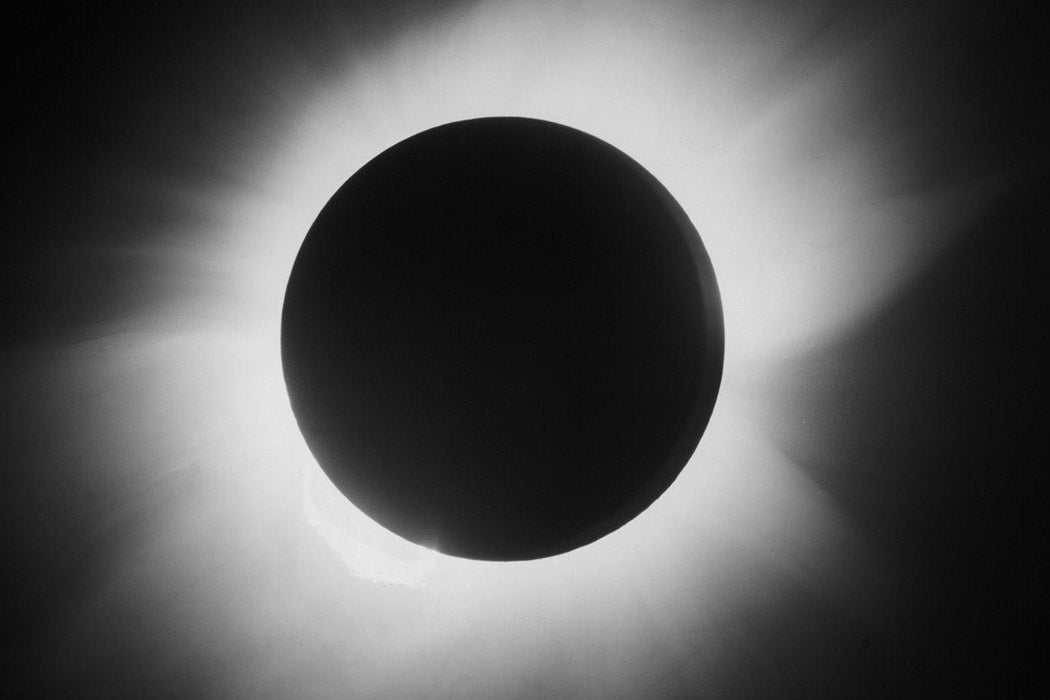Solar eclipses aren’t just astonishing spectacles that have historically been feared, revered, and, more recently, social media-ed. They’re also fast-moving moments of scientific experiment and discovery. Perhaps the most famous example of this was the total eclipse of May 29, 1919. Visible in South America and Africa, the eclipse was observed by two Royal Astronomical Society (RAS) expeditions sent to test a German theoretician’s un-Newtonian notion that gravity could deflect or bend light.
As it turned out, the German theoretician, Albert Einstein, was correct. The theory of general relativity, first presented to the Prussian Academy of Science in November 1915, was very much boosted by this practical demonstration of the bending of starlight around the massive gravity of the sun. The Times of London heralded the results: “Revolution in Science/New Theory of the Universe/Newtonian Ideas Overthrown.” The New York Times headlined “A New Physics, Based on Einstein.” And Einstein was launched into world fame.
The fact that it was a British effort that confirmed a German theory in the immediate aftermath of the disasters of the Great War is the subject of Matthew Stanley’s exploration of Arthur Stanley Eddington’s “expedition to heal the wounds of war.” As Stanley writes, the expedition
became an event steeped in political, moral, and religious meaning. Einstein and relativity became a focal point through which Eddington could advance both science and international understanding. In practice, these two goals blurred together, as he truly felt that astronomy could not progress in a world wracked by hatred and war.
“Science was above all politics,” declared British physicist Sir Oliver Lodge at the beginning of the war in 1914. The brutal reality of the fighting ended such notions for many British scientists. “Anti-German sentiment and wartime hatred” became intense, writes Stanley. One of the RAS’s most dedicated pre-war internationalists was calling for the expulsion of the Germans from the international scientific community by 1916. There was plenty of sentiment that such an expulsion should last beyond an end to the hostilities.
One dissenter to the general anti-Hun feeling was A. S. Eddington, Plumian Professor of Astronomy and Experimental Philosophy at Cambridge University. A member of the Religious Society of Friends (Quakers), Eddington was a pacifist and “called for a future not embittered by the war.” He argued that astronomy in particular was necessarily international, requiring global cooperation. A case in point: Eddington, then Secretary of the RAS, was one of the first Brits to hear about Einstein’s new theory, via a Dutch astronomer. Eddington became “virtually the only defender of the theory” in Britain. Not least cause of the antipathy towards Einstein’s theory was its origin in an enemy country.
Along with Astronomer Royal Frank Dyson, Eddington pushed for an expedition to test Einstein’s theory of gravity by measuring starlight passing the Sun during the 1919 eclipse. It would be some years before an equally suitable solar eclipse event would occur again. Planning began a year before the war’s end.
“This expedition was just the sort of work that required the international cooperation that Eddington had argued was fundamental to the spirit of science,” Stanley writes. “Further, it offered an opportunity to bring a peace-loving, insightful German to prominence in both science and society.”
Weekly Newsletter
Ultimately, in the face of tremendous logistical challenges, two expeditions were sent, both tasked with observing the light from stars in the constellation Taurus. One group went to Sobral, Brazil. Eddington led the group sent to Principe off the west coast of Africa. Having been in some danger of being imprisoned for his conscientious objection to conscription, Eddington was ultimately exempted from conscription on the condition that he participate in the expedition—which, of course, is what he wanted to do.
Einstein would write to The Times praising the “high and proud tradition of English science” in those who set out “to test a theory that had been completed and published in the country of their enemies in the midst of war.” From one pacifist/scientist to another, that would have been music to Eddington’s ears.
Teaching Tips
Incorporate (fun) primary sources:
- Discuss this 1920 article from Scientific Monthly about the 1919 eclipse and the “Einstein effect.”
- Use an 1836 broadsheet to discuss the difference between total and annular eclipses.
Bring the Sun inside (the classroom):
- Teaching 3D design? Science Scope has some suggestions.
- Cloudy outside? Learn how to simulate a solar eclipse.
- Showing students how to safely observe the Sun.
- What will your students want to know?







